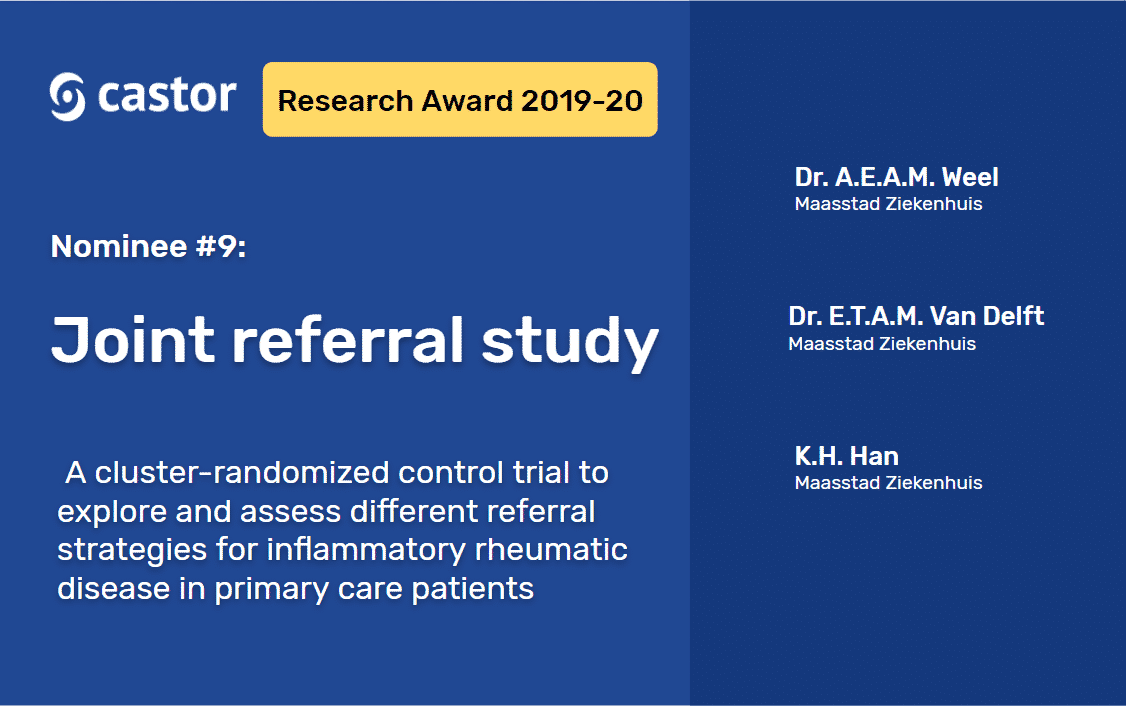Patients suffering from arthralgia at risk of an inflammatory rheumatic disease depend on an appropriate referral. But general practitioners can have difficulty recognizing inflammatory rheumatic diseases. Castor Research Award Nominee #9 will use the JOINT Referral study to explore and assess different referral strategies for inflammatory rheumatic disease in primary care patients.
Research Overview
For inflammatory rheumatic disease patients, getting the right patient at the right location is important to maintain and optimize their quality of life. That is why it is essential to have an appropriate referral by a general practitioner. However, general practitioners may have difficulties recognizing inflammatory rheumatic diseases. This JOINT Referral study aims to assess the effect and cost-effectiveness of different referral strategies for inflammatory rheumatic diseases in primary care patients by comparing them with usual care.
About the team
The principal investigator for this study is Rheumatologist Dr. A.E.A.M. Weel. The study is conducted by Dr. E.T.A.M. van Delft, Ph.D. student, and human-movement scientist. Rheumatologist K.H. Han supports the study along with research nurses from the rheumatology department at the Maasstad Hospital and several students
Study design and methodology
This JOINT referral study follows a cluster randomized controlled trial design where primary care clinics are regarded as clusters. General practitioners from Southwest-The Netherlands are invited to participate. They are randomly assigned to either one of the two strategic interventions for referring adult patients who are, in the opinion of the general practitioner, suspected of inflammatory rheumatic disease:
1) Standardized referral algorithm based on existing referral models PEST, CaFaSpA, and clinical suspect arthralgia
2) Triage by a rheumatologist in the local primary care clinic
The control group will consist of newly referred patients to the rheumatology outpatient clinic of the Maasstad Hospital without the interference of one of the referral strategies (usual care).
Research outcome
The effect of the referral strategies will be measured at three different levels:
- Patient-reported outcomes (quality of life)
- Process (number of appropriate referrals by general practitioners)
- Costs (work productivity and healthcare resources utilization)
The primary outcome is the percentage of patients diagnosed with an inflammatory rheumatic disease by the rheumatologist after twelve months. Secondary outcomes are quality of life, work participation, and healthcare costs. These data, including demographic and clinical parameters, are prospectively collected at baseline, three, six, and twelve months. Our target is to include about 900 patients with 296 patients in each study group (power level 0.8).
How JOINT referral study team uses Castor
Castor is used to track the participants invited and eventually included in this study. Questionnaires are sent directly from Castor to the participants at different predefined timepoints. The completed questionnaires are saved in Castor, where the data will be used for analysis.
“What helps us a lot is that we can use Castor to send out questionnaires at predefined time points,” said Elke van Delft. “The participants find the emails, links, and questionnaires via Castor very easy to use. This helps us in gathering the data we need without too much trouble.”
Stay tuned on the Castor EDC blog for more 2019-2020 Castor Research Awards nominations. We wish the nominees good luck and smart science—and encourage all researchers to share their projects for the chance to win €3000!

